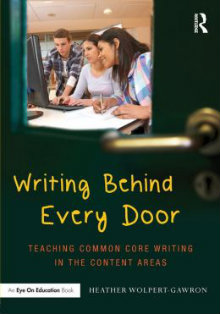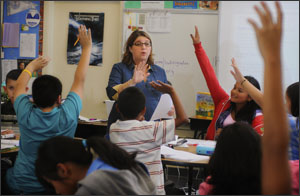Meet Writing Challenges in All Content Areas
Writing Behind Every Door: Teaching Common Core Writing in the Content Areas
By Heather Wolpert-Gawron
(Routledge, 2014 – Learn more)

I have a shelf full of half-read educational reference books that provided nothing I could use on Monday morning with my students. But the book Writing Behind Every Door by Heather Wolpert-Gawron kept my attention from start to finish.
I made notes all the way through. The book was relevant to my work as an ELA teacher and as an instructional coach in all subject areas. Even the title provides multiple delightful meanings–not only is writing a subject that all teachers should use “behind their own classroom doors,” but it is also something that can be scary like a movie monster hiding behind a creaky door.
Luckily, the author opens her classroom door wide to help non-ELA teachers face their fears about using writing as a teaching tool.

I found a handle in the chapter on project-based learning which I shared with a Business Technology Teacher who was having trouble teaching students to design a small business model. Drawing on the book’s advice, she developed a series of lessons starting with developing company logos and letterhead designs.
Every chapter in Writing Behind Every Door goes on to display multiple authentic classroom assignments and student work and concludes with practical resources.
Writing as argument
Writing Behind Every Door follows its own advice about argument as a writing genre. It starts by providing the basic structure of argument writing (thesis, evidence, commentary) in a way that is clear and useful to both ELA and non-ELA teachers.
It then presents the thesis that various types of writing are necessary not just in academics but also in life, gives many examples with real classroom scenarios (such as the “Breaking the Google Homepage Habit,” which asks students to evaluate and utilize a variety of research sources), and shows many authentic student work samples along with the instructional implications.
One source Wolpert-Gawron references is the Partnership for 21st Century Skills, which lists four elements, or 4 C’s, that are critical for student success: Creativity. Collaboration. Critical Thinking. Communication. The author makes a case for project-based writing as a practical way to implement the 4 C’s and provides specifics in her “Ten Reasons to Teach Using Project-Based Learning.”
Informational Writing
Informational writing is another genre that is relevant in modern life. The author creates a powerful image about the knowledge and experiences to which we expose students. “The more you bridge the outside world with what you are doing…the more meaningful the material and the more buy-in from the students,” she writes.
As Wolpert-Gawron describes an informational classroom project she notes: “The students became experts in either historical or scientific facts….I guided them on how to communicate and maneuver through their subjects. The writing that I guided them toward became the vessel that delivered the material.”
Such project-based learning can help reduce that fear of writing. Narrative writing is also mentioned, as the author dispels the notion that it is less relevant in the upper grades and emphasizes the importance of narrative in our lives. “Narrative strategies infuse your content with creativity and that added layer of student personality aids in the ownership of the content,” and she adds that weaving narrative into various other types of writing can make any piece more lively and powerful when done skillfully.
She also argues against the compartmentalizing of school subjects and writing genres. “Only if we break down the walls between subjects will we be able to truly guide students to transfer what they learn from class to class and from school to the world beyond.” Students as well as teachers should be able to pass seamlessly through the doors from one content area to the next.
Thorough lessons in content areas
For non-ELA teachers still apprehensive about opening their doors, I recommend the chapters “Summary: Get to the Point! The Underrated Writing Genre” and “Techniques to Teach Writing That Works.” Both have very detailed and specific lessons, with content area examples that any teacher can use on Monday morning.

Learn to love the teaching of writing
If you read this book you may actually learn to enjoy the creaky opening of that potentially scary door that is writing instruction, and you will be able to peer happily around the solid barrier. You and your students will benefit from being able to travel with ease through various content area doorways.
Kathleen Pham is a National Board Certified Teacher who has taught Language Arts in Miami-Dade County Public Schools for over 30 years. Her favorite aspect of the job is teaching writing, which she attributes to one of her own high school English teachers who taught the writing process before it was fashionable, and she strives to similarly inspire her own writing students.




































